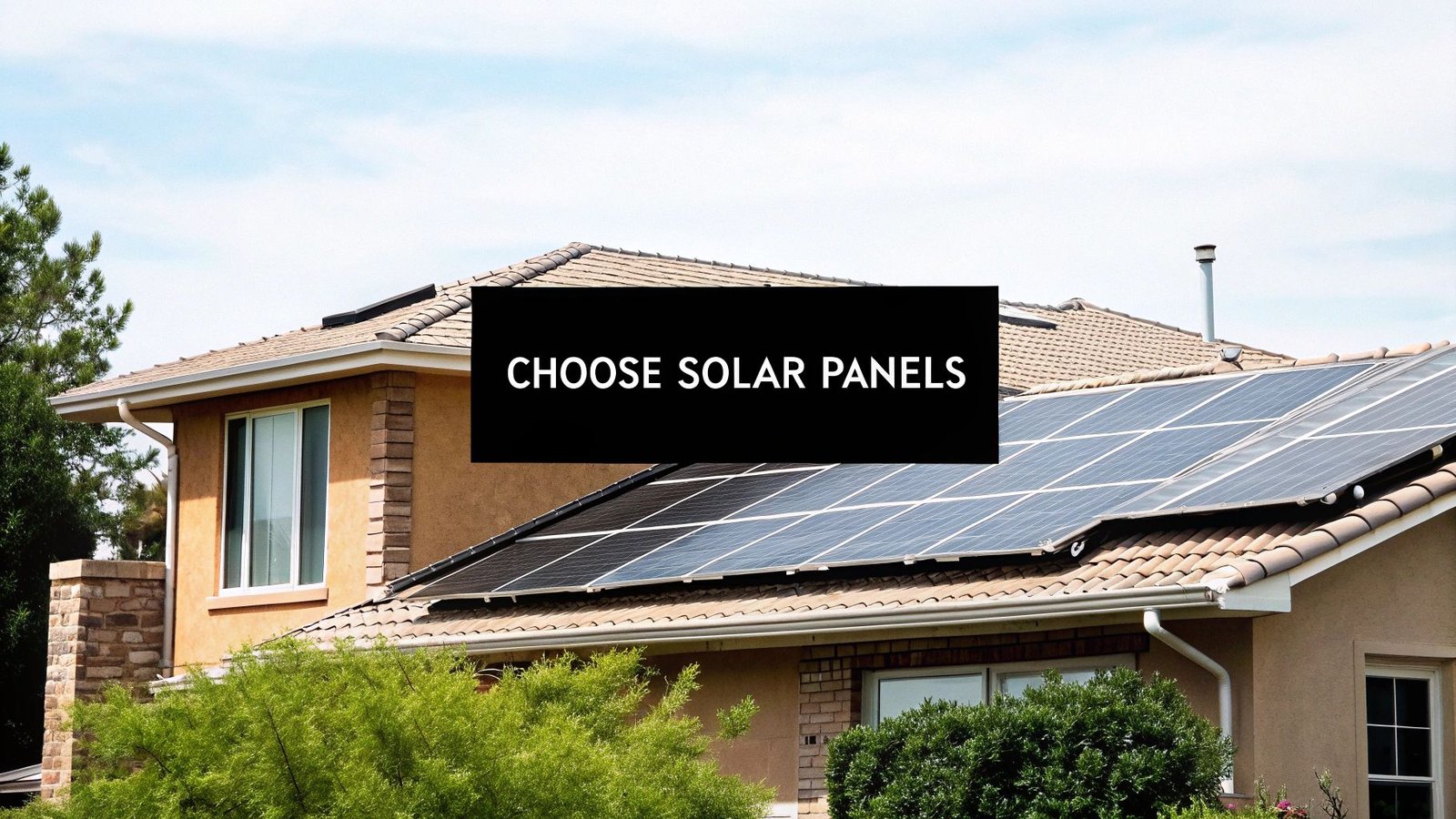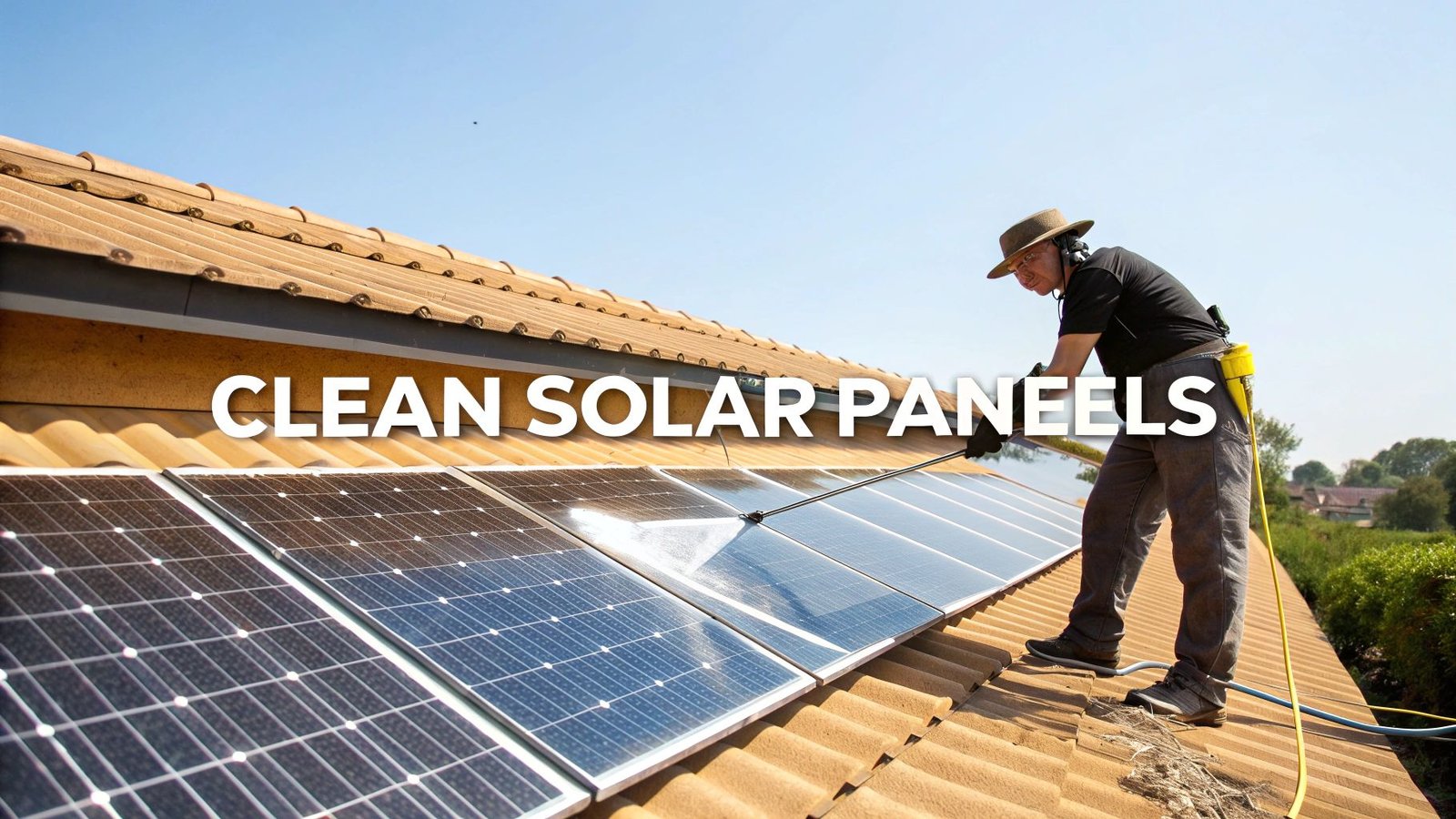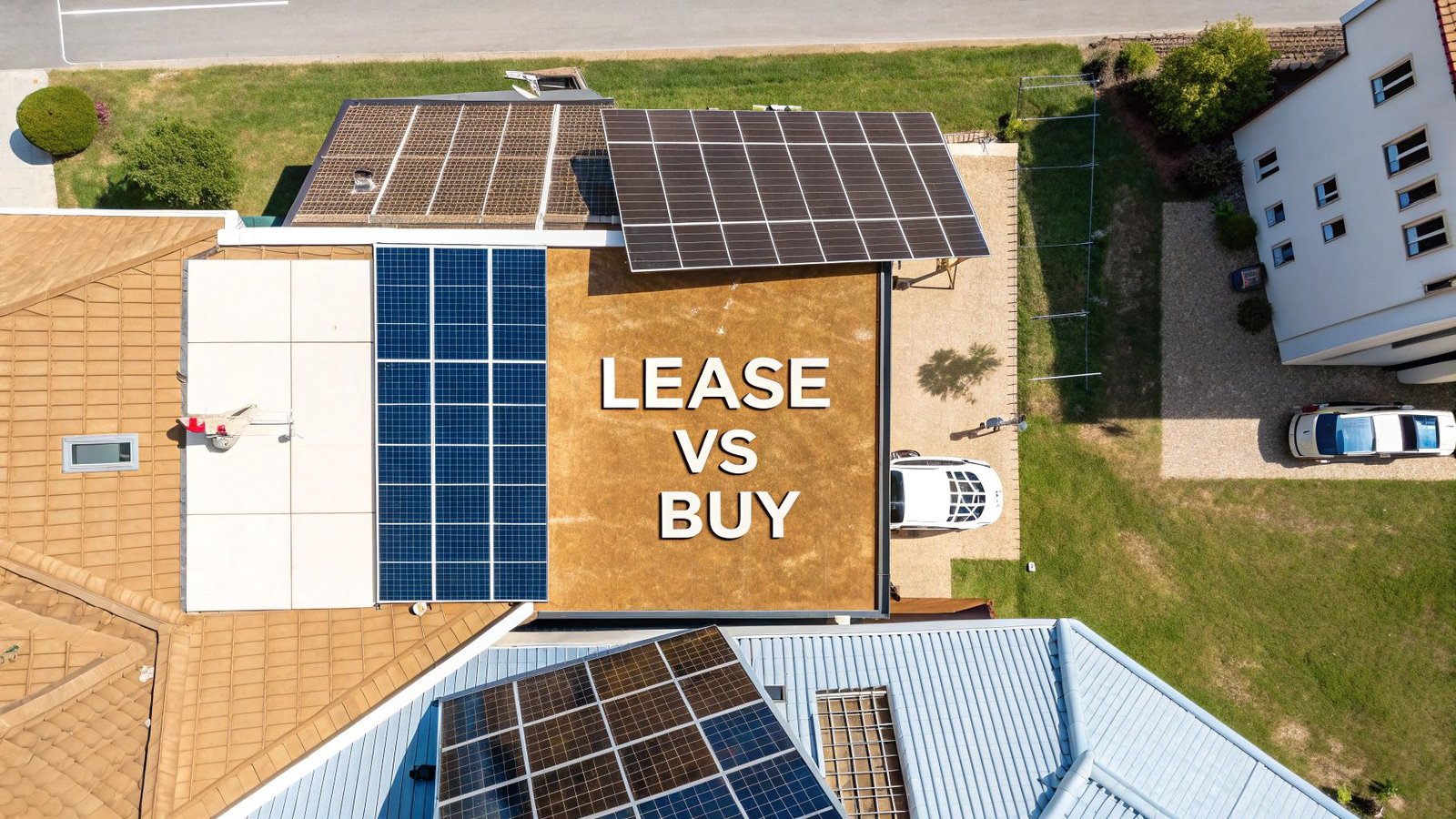When you're trying to figure out which solar panels are right for you, it's easy to get bogged down in technical jargon. The truth is, the whole decision really comes down to just four key things: panel efficiency, the total installed cost, the technology behind the panel, and the warranty that backs it all up.
If you can get a good handle on these four pillars, you'll be in a fantastic position to choose a system that delivers value for years to come.
Your Starting Point for Choosing Solar Panels
Navigating the world of solar panels can feel overwhelming, with every company claiming they have the best product. The trick is to ignore the noise and start with a solid foundation. Think of this as building a house—you need to get the four cornerstones right before you worry about the paint color.
Once you understand these fundamentals, you'll be able to look at any quote, talk to any installer, and know exactly what questions to ask. It’s about making a confident decision for your home’s energy future.
The Four Pillars of Your Decision
Every solar panel quote you review should be measured against these four critical areas. They directly influence how much you'll save over the next 25+ years and how reliable your system will be.
-
Efficiency: This is simply the percentage of sunlight a panel can convert into usable electricity. If you're working with a small roof or have some shading to contend with, higher efficiency is your best friend. It lets you squeeze the most power out of a limited space.
-
Total Cost: Don't get fixated on the price of the panel itself. The number that really matters is the cost per watt ($/W). This metric levels the playing field, allowing you to make a true apples-to-apples comparison between different equipment packages and installers.
-
Technology Type: You’ll mainly see three types: monocrystalline, polycrystalline, and thin-film. Each comes with its own trade-offs in efficiency, cost, and even appearance. The right one for you really depends on your budget and what you prioritize—peak performance or upfront savings.
-
Warranty: A solar installation is a long-term investment. You're buying an asset that should perform for a quarter of a century. A robust product and performance warranty is your safety net, protecting you from manufacturing defects and guaranteeing your panels will keep producing power at a high level for decades.
I see this all the time: a homeowner gets laser-focused on finding the absolute cheapest panel or the one with the highest efficiency rating. The smartest choice is almost always a balanced one that fits your specific roof, your local climate, and your financial situation.
To help you keep these factors straight, here’s a quick reference table.
Quick Guide to Solar Panel Decision Factors
This chart is a great way to quickly weigh the most important factors when you're comparing your options for solar panels.
| Decision Factor | What to Look For | Why It Matters |
|---|---|---|
| Efficiency | Higher percentage (e.g., 20-22%) | More power from less space; crucial for small or partially shaded roofs. |
| Cost | Low cost per watt ($/W) | Measures the value you get for your investment, not just the panel price. |
| Warranty | 25-year product and performance warranties | Protects your investment against defects and ensures long-term energy output. |
| Technology | Monocrystalline for efficiency, Polycrystalline for budget | Matches the panel's performance and aesthetics to your specific needs. |
Think of this table as your cheat sheet. When you're looking at different proposals, you can quickly check them against these benchmarks to see how they stack up.
Decoding Solar Panel Efficiency and Performance
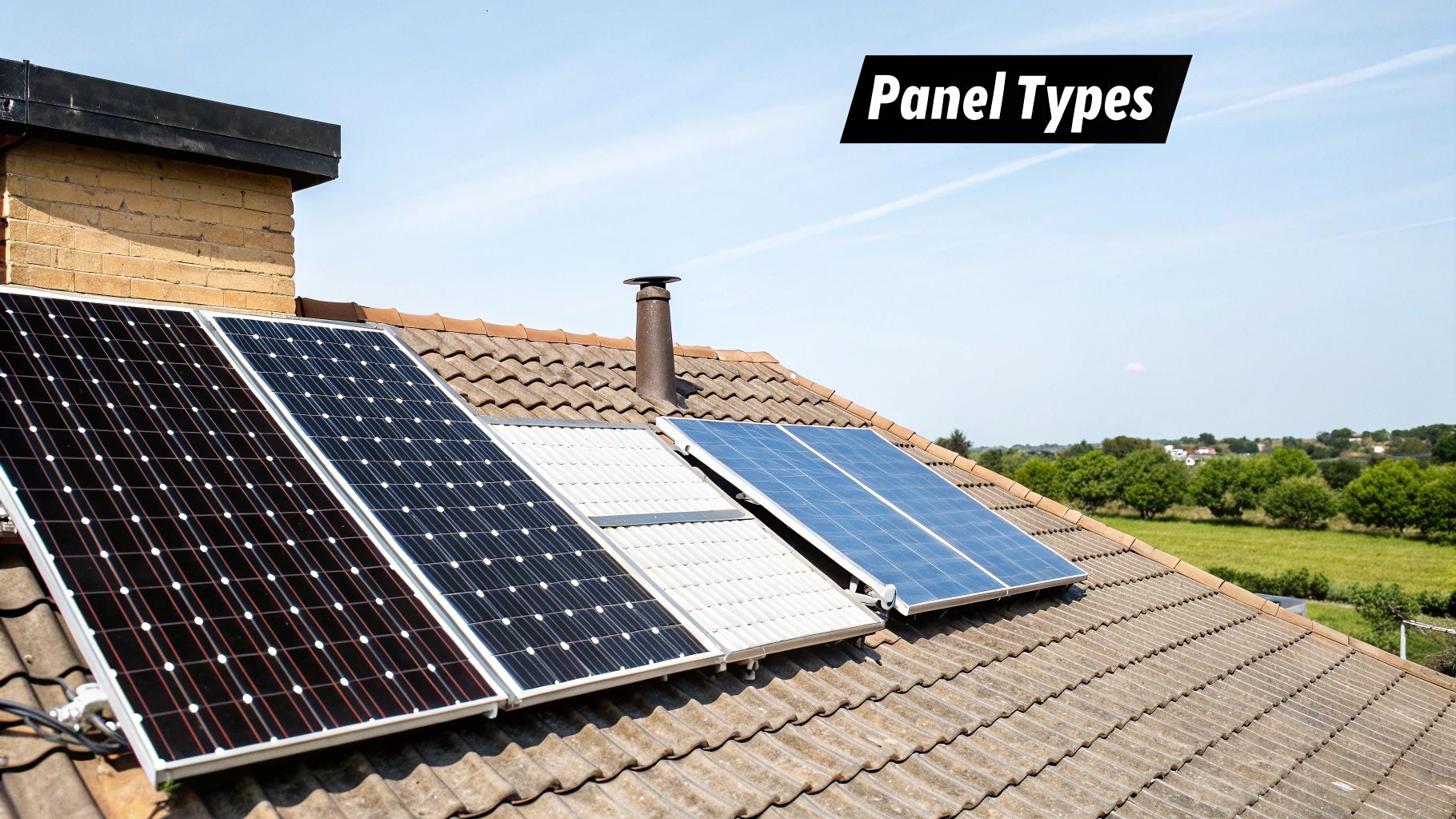
When you start shopping for solar panels, the efficiency rating is usually the first number you’ll see. But what does it actually mean for your home and your wallet? Simply put, efficiency tells you how much of the sunlight hitting a panel gets turned into electricity you can actually use.
Right now, most of the silicon-based panels you'll find for your home have efficiency ratings somewhere between 15% and 22%.
That percentage might seem a bit abstract, but it has a real-world impact, especially when it comes to the size of your roof. Higher efficiency just means you can generate more power from a smaller footprint. This is a game-changer for homes with limited or awkwardly shaped roof space. For a deeper dive into how market trends are shaping the panels available today, the global outlook for solar power from SolarPower Europe is a great resource.
Efficiency in Action: A Tale of Two Roofs
To see how this plays out, let's look at two different homes, both wanting to generate around 8,000 kWh of electricity a year.
-
Home A is a modern townhouse with a small, 400-square-foot patch of usable roof. To hit their energy target, they'll need high-efficiency 22% panels. These panels pack more punch per square foot, making it possible to fit a system that fully covers their electricity needs.
-
Home B is a classic ranch-style house with a huge 1,000-square-foot roof. They can easily reach that same 8,000 kWh goal with more budget-friendly 18% efficiency panels. Since they have plenty of room to work with, they can install a larger array without paying the premium for top-of-the-line efficiency.
The takeaway here is that the "best" efficiency isn't always the highest number on the spec sheet—it's the one that makes the most sense for your roof and your budget.
The Temperature Coefficient: Surviving the Summer Heat
A panel’s performance isn't set in stone; it fluctuates with the weather. This is where the temperature coefficient comes in. It’s a crucial, but often overlooked, number that shows you how much a panel's output will drop as it gets hotter. It’s measured as a percentage dip for every degree Celsius (°C) above a baseline of 25°C (77°F).
For instance, a panel with a temperature coefficient of -0.30%/°C is going to hold up better on a hot day than one rated at -0.40%/°C. On a blazing 35°C (95°F) afternoon, that seemingly small difference adds up, affecting how much power you generate right when your air conditioner is working its hardest.
How Much Power Will You Really Have in 20 Years?
Finally, you have to consider the degradation rate. This tells you how much a panel’s power output is expected to decline, year after year. Every panel loses a tiny bit of its performance over time—it's an unavoidable consequence of being exposed to sun, rain, and snow for decades.
A premium panel might have a first-year degradation of just 0.5% and then a tiny 0.25% dip each following year. On the other hand, a lower-tier panel could degrade by 1.0% in its first year and 0.5% annually after that.
A solar panel isn't a one-time purchase; it's a 25-year energy-generating asset. Understanding its degradation rate helps you forecast its long-term value and ensure it will still meet your needs decades down the line.
The chart below really highlights how a small difference in degradation can compound over the life of your system.
graph TD
subgraph Year 1
A[High-Quality: 99.5%]
B[Standard: 99.0%]
end
subgraph Year 10
C[High-Quality: 97.25%]
D[Standard: 94.50%]
end
subgraph Year 25
E[High-Quality: 93.50%]
F[Standard: 87.00%]
end
A --> C --> E
B --> D --> F
| Metric | High-Quality Panel | Standard Panel |
|---|---|---|
| Initial Output | 100% | 100% |
| Output at Year 10 | 97.25% | 94.50% |
| Output at Year 25 | 93.50% | 87.00% |
Comparing the Different Types of Solar Panels
When you start digging into solar panels, you’ll find three main technologies dominate the residential market: monocrystalline, polycrystalline, and thin-film. Choosing the "best" one isn't about picking the most expensive or high-tech option. It’s about finding the right fit for your home, your budget, and what you want your system to look like.
Think of it like buying a car. A two-seater sports car is perfect for some, but a family of five needs a minivan. The best choice depends entirely on your specific situation.
Monocrystalline: The Efficiency Leader
If you have a smaller roof or just want to squeeze every last watt of power out of your available space, monocrystalline panels are almost always the answer. They're crafted from a single, pure silicon crystal, which makes them the most efficient panels you can buy today. Their uniform, sleek black look is also a big draw for homeowners who want a clean, modern aesthetic.
Because they’re so efficient, you don’t need as many of them to hit your energy goals. This is a huge advantage for townhouses, homes with complex rooflines, or roofs with obstructions like chimneys and vents. They do come with a higher price tag, but you're paying for premium performance and looks.
Polycrystalline: The Reliable Workhorse
Got a big, wide-open roof with plenty of sunshine? Polycrystalline panels are a fantastic, budget-friendly choice. These panels are made from melted fragments of multiple silicon crystals, a process that’s less costly. You can usually spot them by their signature blue, marbled appearance.
They aren't quite as efficient as monocrystalline panels, but the lower cost makes them a smart investment for homeowners who have the space to spare. For a large, sprawling roof, polycrystalline panels can deliver all the power you need without the premium price.
The choice between monocrystalline and polycrystalline often boils down to a simple trade-off: Are you optimizing for limited space and a sleek look, or are you prioritizing a lower upfront cost with plenty of room to work with?
The image below gives you a good visual breakdown of the typical efficiency ranges for the main panel types.
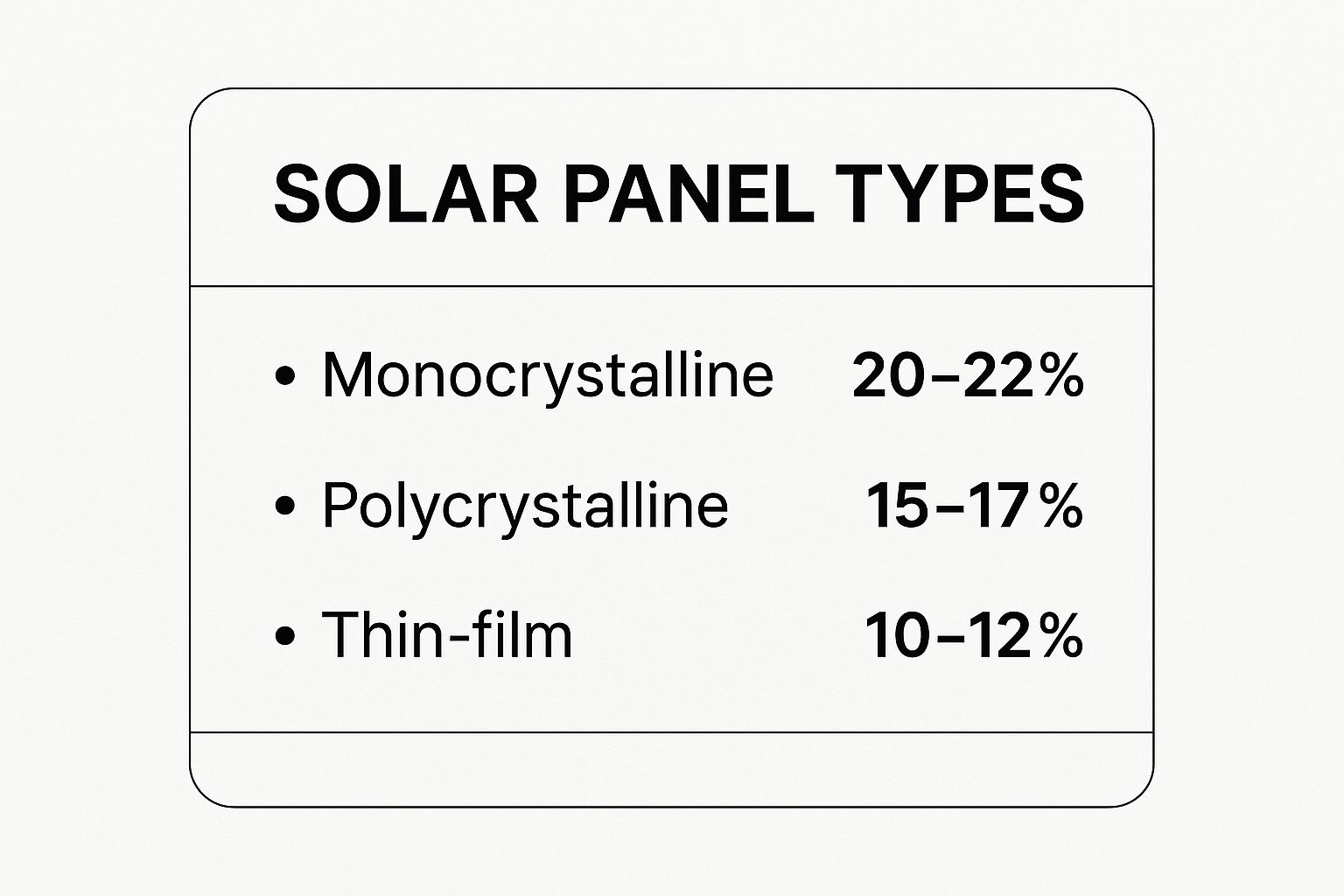
As you can see, monocrystalline technology leads the pack in converting sunlight to electricity, making it the clear winner when every square foot of roof space counts.
Thin-Film: The Flexible Specialist
Finally, we have thin-film panels. You won't see these on many residential rooftops because their efficiency is significantly lower, but they are incredibly useful in specific situations. Their main advantage is being lightweight and flexible, which means they can be installed on surfaces that can’t handle the weight or rigidity of traditional panels.
Thin-film technology is perfect for specialty applications like:
- RVs, campers, and boats
- Uniquely curved architectural roofs
- Portable, roll-out solar chargers
While they’re not the standard for a home installation, they solve problems that other panels simply can't.
Solar Panel Technology Comparison
To make things even clearer, here’s a side-by-side comparison of the most common solar panel types. This should help you decide which technology is the best match for your home's needs and your budget.
| Panel Type | Efficiency Range | Cost | Best For | Appearance |
|---|---|---|---|---|
| Monocrystalline | 17% – 22%+ | Higher | Limited roof space, high energy needs, premium aesthetics | Sleek, uniform black |
| Polycrystalline | 15% – 17% | Lower | Large, unobstructed roofs, budget-conscious projects | Blue, marbled look |
| Thin-Film | 10% – 13% | Varies | RVs, boats, portable use, non-traditional surfaces | Thin, flexible black sheets |
Ultimately, the right panel technology is the one that best balances efficiency, cost, and aesthetics for your unique property. Understanding these key differences is the first step toward making a confident and informed decision.
Making Sense of Solar Panel Costs and Financial Incentives
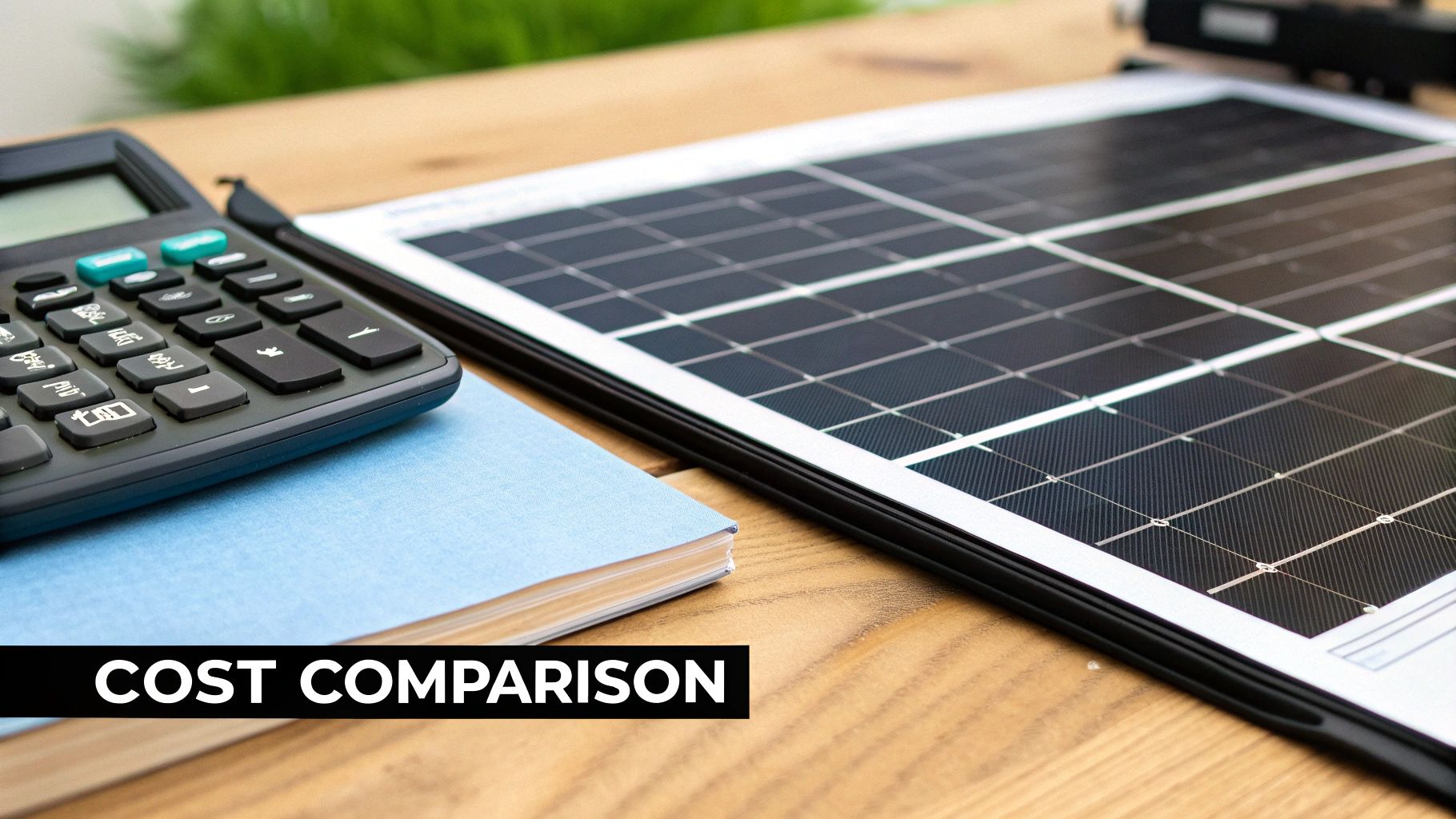
Let's talk about the money. Understanding the financial side of going solar is just as critical as picking the right hardware. The initial sticker price of a solar system can feel intimidating, but it's essential to look past that number to see what you're actually paying for—and more importantly, how you can bring that cost way down.
The total price tag on a solar installation covers a lot more than just the panels. You’re also paying for the mounting hardware, all the wiring, the crucial inverter system, and the skilled team doing the work. It’s true that higher-efficiency panels can cost more upfront, but they often pay for themselves faster by generating more power over the system's typical 25-year lifespan. The global market for solar is expanding rapidly, a trend you can explore in more detail by reviewing market data on global solar energy systems.
The Best Way to Compare Quotes: Cost Per Watt
When you start collecting quotes from installers, the total prices can be all over the map. To get a true apples-to-apples comparison, you need to look beyond the bottom-line number and focus on a key metric: the cost per watt ($/W).
This is your secret weapon for evaluating value. The calculation is simple.
Cost Per Watt ($/W) = (Total System Cost – Incentives) / Total System Wattage
For instance, say you get a $20,000 quote for a 6,000-watt (6 kW) system. That works out to $3.33 per watt. Now, imagine another company quotes you $18,000 for a smaller 5,000-watt (5 kW) system. While the total price is lower, the cost per watt is actually higher at $3.60. In this case, the first quote offers better value for your money.
How Incentives Dramatically Lower Your Cost
This is where that initial sticker price starts to shrink. Financial incentives are designed to make solar more affordable, and they can slash your upfront investment in a big way.
Here’s what you should be on the lookout for:
- Federal Solar Tax Credit: This is the big one. It's a powerful credit that lets you deduct a huge percentage of your total system cost directly from what you owe in federal taxes.
- State Rebates and Tax Credits: Many states sweeten the deal with their own rebates or tax credits, which you can often stack on top of the federal incentive.
- Local and Utility Perks: Don't forget to check with your local government or utility provider. They might offer cash rebates or even performance-based incentives that pay you for the energy your system produces.
A Real-World Example: Putting It All Together
Let's walk through how these savings stack up in a typical quote. Imagine you’re looking at a 7kW system.
pie
title Solar System Cost Breakdown (7kW System)
"Net System Cost ($13,700)" : 65
"Federal Tax Credit ($6,300)" : 30
"State Rebate ($1,000)" : 5
| Item | Cost/Credit | Description |
|---|---|---|
| Gross System Cost | $21,000 | The starting price before any incentives ($3.00/W). |
| Federal Solar Tax Credit | -$6,300 | A 30% credit you'll claim on your federal tax return. |
| State Rebate | -$1,000 | A one-time cash rebate from your state's energy program. |
| Net System Cost | $13,700 | Your final out-of-pocket cost after all incentives. |
In this scenario, the incentives knock over 35% off the top, turning a major expense into a much more manageable investment. This "net system cost" is the real number to focus on when calculating your payback period and long-term savings, which often lands somewhere in the 5 to 10-year range for most homeowners.
Evaluating Warranties and Manufacturer Reliability
Think of your solar energy system as a 25-year commitment. It’s a long-term relationship, and just like any major investment, the warranty that backs it up is one of the most critical things to scrutinize. This is about more than just protecting a purchase; it’s about making sure your system delivers value for decades to come.
When you dive into the paperwork, you'll see two distinct warranties. It's crucial to understand how each one protects you.
The Product Warranty Explained
First up is the product warranty. This one is pretty straightforward—it covers the physical solar panel itself. You can think of it as the bumper-to-bumper warranty on a car.
This warranty protects you from manufacturing defects, problems with materials, or unusual damage from the elements. A solid product warranty will run for 12 to 25 years. If a panel gives out because of a defect during that time, the manufacturer is on the hook to replace it. A longer warranty is a great sign; it shows the manufacturer has real confidence in its build quality.
Decoding the Performance Warranty
The second layer of protection is the performance warranty. This guarantees a specific level of energy output over the long haul, accounting for the slow, natural decline in efficiency called degradation.
Every solar panel loses a tiny fraction of its output potential each year. The performance warranty puts a floor on that loss, promising it won't dip below a certain point.
The industry standard is a guarantee that panels will still operate at 80% or more of their original power output after 25 years. But the best manufacturers raise that bar, promising 87% or even higher—a clear signal of a premium, more durable product.
Let's put that into perspective. A top-tier panel might be guaranteed to produce 90% of its original power in year 25, while a standard panel might only be guaranteed for 82%. That 8% gap represents a significant amount of lost electricity production—and savings—over the lifetime of your system.
How to Evaluate Manufacturer Reliability
A warranty is only worth the paper it's printed on if the company is still around to honor it. Since you're relying on this protection for a quarter of a century, you need to feel confident the manufacturer will be there if you need them. This is what the industry calls bankability.
Here are a few things I always look for when assessing a manufacturer’s long-term stability:
- Years in Business: A company with a proven history is a safer bet. I look for manufacturers that have been navigating the industry for at least 10+ years.
- Financial Health: It can be tough to get a full picture of a private company's finances, but you can look for positive signs like being publicly traded or having the backing of a large, stable parent corporation.
- Third-Party Validation: Independent labs like TÜV Rheinland or PVEL (PV Evolution Labs) put panels through rigorous stress tests. A seal of approval from them is unbiased proof that the product is built to last.
The solar industry is incredibly competitive. A quick look at current solar energy statistics and market trends shows the massive scale of global manufacturing. Choosing a reputable, bankable brand from this crowded field is one of the smartest moves you can make to safeguard your investment.
Finding and Vetting Your Solar Installer
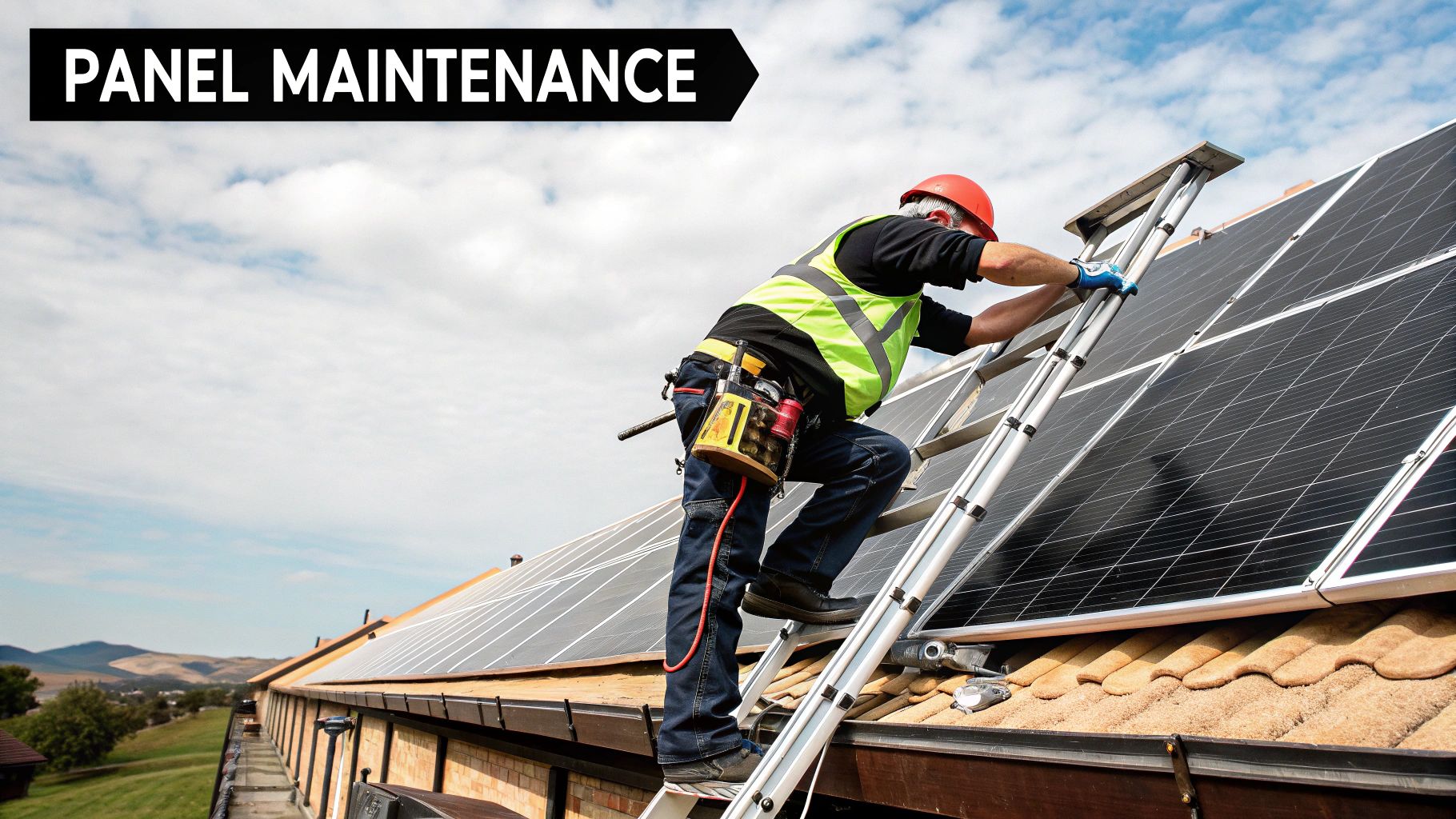
You can spend weeks picking out the perfect, most efficient solar panels, but if they're installed poorly, none of that matters. A botched installation can lead to a whole host of problems—roof leaks, electrical hazards, and a system that just doesn't produce what it should. This turns a fantastic investment into a years-long headache.
Honestly, choosing the right installer is just as critical as choosing the right panels. This is the final, crucial step where your research meets reality. A great installation partner makes sure your system is safe, optimized for performance, and built to last.
Credentials That Matter
Before you even start talking about quotes, you need to do a little homework on the company itself. This isn't the place to cut corners.
The single most important credential to look for is NABCEP (North American Board of Certified Energy Practitioners) certification. Think of it as the gold standard for solar professionals. It’s a clear sign that the installer has passed rigorous exams and has proven, hands-on experience.
Beyond that, you absolutely must confirm they have:
- Proper State and Local Licensing: This is non-negotiable. It proves they're legally permitted to work in your area.
- Comprehensive Insurance: Always ask to see their certificates for general liability and worker’s compensation. This protects you from any liability if an accident happens on your property.
A reputable installer will have no problem showing you their credentials; in fact, they should be proud of them. If a company gets cagey or hesitant when you ask for proof of their license, insurance, or NABCEP status, that’s a massive red flag. Walk away.
Key Questions to Ask Every Potential Installer
Once you’ve confirmed their basic qualifications, it's time to dig in. You’re not just buying equipment; you’re hiring a team for a major construction project on your home. Treat it like a job interview.
Have a list of questions ready that go beyond just the bottom-line price.
- "How much experience do you have with my specific roof type?" Installing on asphalt shingles is a world away from installing on Spanish tile or standing-seam metal. You want a team that knows the unique challenges of your roof.
- "Who is responsible for the permits and interconnection paperwork?" A full-service installer should handle all of it. You have enough to worry about without navigating bureaucracy with your utility and local building department.
- "What does your workmanship warranty cover, and for how long?" This is completely separate from the manufacturer warranties on your panels and inverters. It covers the installation quality itself—things like leaks or loose connections. Look for a warranty of at least 10 years.
- "Can I speak with a few of your recent customers?" Talking to past clients is one of the best ways to get a real feel for a company's professionalism, communication, and follow-through.
Comparing Your Quotes Side-by-Side
It's smart to get at least three quotes. When they start rolling in, your first instinct will be to scan for the lowest number. Resist that urge. A surprisingly low bid can be a sign of corners being cut, whether that means inexperienced labor, cheaper racking and wiring, or just an inaccurate system design.
To make a true apples-to-apples comparison, lay out the details in a simple chart.
| Comparison Point | Quote 1 (Installer A) | Quote 2 (Installer B) | Quote 3 (Installer C) |
|---|---|---|---|
| Total Cost ($) | |||
| Cost Per Watt ($/W) | |||
| Panel Brand & Model | |||
| Inverter Brand & Model | |||
| Workmanship Warranty | |||
| NABCEP Certified? |
By looking at the complete picture—credentials, experience, and the total value offered—you can confidently choose an installer who will set you up for decades of clean energy savings.
Answering Your Final Questions About Solar Panels
Alright, you've waded through the technical specs—efficiency ratings, warranties, and panel types. But even with all that knowledge, some practical questions always pop up right before you're ready to pull the trigger.
Let's walk through some of the most common ones I hear from homeowners. Getting these squared away is often the last step to feeling truly confident in your decision.
How Many Solar Panels Do I Actually Need?
This is the big one, and the honest answer is: it's a custom calculation. Figuring out the right number of panels is a balancing act between how much electricity you use, the amount of sun your home gets, and the power of the panels themselves.
The starting point is always your old power bills. Grab a few and find your average monthly or daily electricity usage, which you'll see listed in kilowatt-hours (kWh). That number becomes your target.
From there, a good installer will factor in your area's peak sun hours—a measure of how much solar energy is available. They'll also perform a detailed site assessment, looking at your roof's direction, pitch, and any shading from nearby trees or buildings that could block sunlight.
Just to give you a rough idea, the average American home uses about 893 kWh per month. To cover that in a sunny state with modern 400-watt panels, you'd likely be looking at a system with 15 to 20 panels.
But please, treat that as a ballpark estimate. Every home is unique. The only way to get a number you can rely on is through a professional site assessment and a detailed quote.
Is the Inverter Brand as Important as the Panel Brand?
Yes. Absolutely. Think of the inverter as the brain of your entire solar operation.
Your panels get all the glory for capturing sunlight and creating DC power, but that's not what your house runs on. The inverter is the workhorse component that converts that raw DC electricity into the AC electricity that powers your lights, appliances, and everything else.
If you cheap out on the inverter, you create a bottleneck that can cripple your whole system, no matter how amazing your panels are. It's a classic case of a chain being only as strong as its weakest link.
You'll generally come across two main types:
- String Inverters: A single, central unit that all your panels connect to in a "string." They're a proven, cost-effective solution, especially for homes with simple, unshaded roofs where every panel performs equally well.
- Microinverters: A small inverter is attached to every single panel. This is the go-to choice for more complex roofs or properties with partial shading. If one panel gets shaded by a cloud or a tree branch, it won't tank the performance of the entire system.
Making sure your inverter comes from a top-tier brand with a solid warranty (10 to 25 years is the standard) is every bit as critical as choosing the right panels.
My Roof Isn't Good for Solar. What Now?
Don't worry, an unsuitable roof doesn't mean you're out of the game. If factors like age, heavy shade, complex angles, or structural issues take your roof out of the running, you still have some fantastic alternatives.
One of the best is a ground-mounted solar system. If you have some open space on your property, we can install panels on a sturdy rack right on the ground. The big advantage here is that we can orient them at the absolute perfect angle to the sun, often leading to even better energy production than a rooftop setup.
Another great route is a community solar program (sometimes called a solar garden). You essentially subscribe to a share of a large, local solar farm. In return, you get credits on your utility bill based on how much power your share generates. It gives you the financial perks of going solar with zero installation on your property—perfect for renters or anyone with a tricky roof.
Ready to explore the best solar options for your home? The experts at Radiant Energy can provide a personalized assessment and design a system that perfectly fits your needs and budget. Visit us to get started on your path to energy independence.

